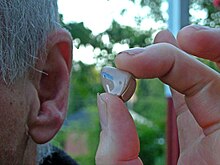User:Hw13na/aging
Hey guy! so if you are editing this page, please look at the actual aging wikipedia website. We created a new section called aging in communication. The edits here are just our rough drafts. Thanks and we look forward to reading your comments!
Ageing in Communication[edit]
Healthy ageing[edit]

- Healthy ageing implies optimal well-being in spite of barriers resulting from age.
[1] The global population is ageing and will continue to have communication inabilities unless barriers of communication with the elderly are more highly promoted.[2]
Barriers to Communication in Ageing:
1.Hearing loss[edit]

- Hearing loss is a common condition among ageing adults. Common conditions that can increase the risk of hearing loss in elderly people are high blood pressure, diabetes or the use of certain medications harmful to the ear.[3] Hearing aids are commonly referred to as personal amplifying systems, which can generally improve hearing by about 50%.[4]
- Hearing loss among the aged community lessens elders ability to compensate for other age related social and/or physical problems.[5] Communication problems of elderly adults can be greatly impacted by mechanical problems such as: the translation of ideas into linguistic representation or expression, the perception of linguistic stimuli or the derivation of an idea from a given unit of disclosure. Changes in these mechanical problems are more important than changes in linguistic knowledge.[5] The main goal of hearing aids is to improve communication and quality of life, not just to restore hearing. Presbycusis is an example of a hearing deficit that cannot be corrected by hearing aids.[4] Presbycusis, the alteration of hearing sensitivity associated with normal hearing loss, is caused by the decreased amount of hair cells of the inner ear.[6] This is normally caused by long periods of distressing noise that diminish the hair cells which with increasing age will not grow back.Presbycusis and other such hearing related problems promote social withdrawal, as individuals begin to lose touch with the world around them. Hearing loss among the aged community lessens elder’s ability to compensate for other age related social and/or physical problems.[6] This impairment can cause elders to lose touch of social skills because in conversation they may have trouble keeping up with fast paced or hearing different pitched voices in conversation.[4]
2. Visual impairment[edit]
- The interpretation of facial expressions and mouthing can be difficult to understand when an individual has a visual impairment. Such problems hinder the ability of people to understand stimuli and translate information pertaining to perception with their brain for analysis.[4] Non-verbal communication is important in effective communication and elders with vision loss are more likely to misinterpret or read the other persons actions in a wrong way. Visual impairments also cause a loss in positive perceptions of the environment around them. This can lead to isolation and possible depression in elderly people.[4] Macular degeneration is a common of vision loss problem in elderly people. It diminishes the macula of the eye, which is responsible for clear vision. It causes progressive loss of central vision and possible colour loss in vision.[4] The cause of this degeneration is due to systemic changes in the circulation of waste products and growth of abnormal vessels around the retina causing the photoreceptors not to receive proper images. Though ageing almost always causes this, other possible effects and risk factors include smoking, obesity, family history and excessive sunlight exposure.[4]
Strategies for Communicating with Ageing Individuals:[edit]
- Allow more time for conversation and conduct conversation in a quiet place.[7]
- Be honest if you don't understand what is being said.[7]
- Repeat back what is being said to make sure you understand.[8]
- Do not cover mouth when speaking and squarely face the speaker.
- Use open-ended questions.[7]
- Use familiar terms when speaking to the individual.
Brittany Trojek 17:45, 28 October 2014 (UTC)
- ^ Worrall, L.,& Hickson, L. M. (2003).Theoretical foundations of communication disability in aging. In Linda E. Worrall & Louise M. Hickson(Eds.). Communication disability in aging: from prevention to intervention (pp. 32-33). Clifton Park, NY: Delmar Learning, 2003
- ^ a b Worrall, L.,& Hickson, L. M. (2003). Implications for theory, practice, and policy. In Linda E. Worrall & Louise M. Hickson (Eds.). Communication disability in aging: from prevention to intervention (pp. 297-298). Clifton Park, NY: Delmar Learning, 2003
- ^ Worrall, L.,& Hickson, L. M. (2003).Communication activity limitations. In Linda E. Worrall & Louise M. Hickson(Eds.). Communication disability in aging: from prevention to intervention (pp. 141-142). Clifton Park, NY: Delmar Learning, 2003
- ^ a b c d e f g Nussbaum, J. F., Thompson, T. L., & Robinson, J. D. (1989). Barriers to conversation. In Jon F. Nussbaum, Teresa Thompson, James D. Robinson (Eds.). Communication and aging (234-253).New York: Harper & Row,1989
- ^ a b Bayles, K., Kaszniak, A., & Tomoeda, C. (1987). Linguistic communication and normal aging. In communication and cognition in normal aging and dementia (pp. 150-152). Boston: Little, Brown and Company.
- ^ a b Touhy, T. A., Jett, K., Ebersole, P., & Hess, P. A. (2012). Communicating with older adults. In Theris A. Touhy & Kathleen (Eds.). Jett Ebersole & Hess' toward healthy aging: human needs & nursing response (96-98).St. Louis, Mo.: Elsevier/Mosby, 2012
- ^ a b c Schaffer, M., & Norlander, L.(2009).Challenges in end-of-life communication. Being present: a nurse's resource for end-of-life communication (pp. 206). Indianapolis, IN :Sigma Theta Tau International, 2009
- ^ Schaffer, M., & Norlander, L.(2009).Understanding the spiritual journey. Being present: a nurse's resource for end-of-life communication (pp. 84-85). Indianapolis, IN :Sigma Theta Tau International, 2009
